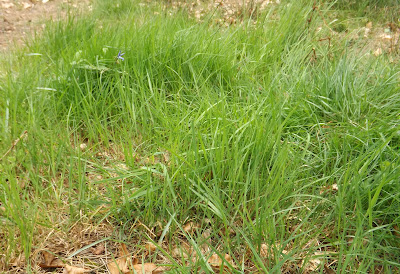 |
| A new patch of Bilberry |
We've been hurrying to search out newly regenerating tree seedlings before the deer eat everything. It's a bit of a race against time. The fallow deer season ends April 30th, and after that it's the closed season until August 1st. So for three months they can run riot in Old Copse eating everything in sight, but especially the tender and tasty newly regenerating shoots. There's been a lot of walking about these past few weeks looking for tiny seedlings to mark with tape before protecting them with recycled tree tubes and home-made hazel stakes. There appears to be much more regeneration than in previous years. This could be due to a number of reasons: the felling of Scots Pine and birch to let in more light; the ongoing routine of bracken bashing which prevents ground flora being buried in mounds of dead bracken, and the gradual reduction in deer numbers .
 |
| Alder seedling in the 'wet wood' |
Here are a couple of photos which show the difference made by bracken management. The first photo shows our 'control' area in the Scots Pine plantation where the Pine has been thinned but no replanting or bracken bashing has been done. Note how dead bracken has smothered the ground flora - no bluebells or very much else can survive in these conditions. In contrast, the two other photos show a couple of areas where the bracken has been ruthlessly removed, and which were devoid of bluebells until this Spring.
We wrote about our spreading patches of wild daffodils in a previous post. Here are some more examples of regenerating ground flora:
 |
| Violets |
 |
| Just outside the cabin - ferns, wood sorrel, birch, grasses |
 |
| New lush grass in a damp spot |
 |
| Rowan emerges in abundance and is usually eaten by deer, but we protect some we want to keep. We'll need to fit a longer tube on the rowan in the photo below . |
 |
| A new patch of heather |
 |
| Woodsage |
 |
| Willow springing up next to the deck |
We're getting much better at growing our own trees . Last December we came across abundant acorns at Wakehurst Place (National Trust/Kew Gardens), 13 miles from Old Copse. They looked especially large and robust, so we gathered a couple of handfuls and plonked them into small pots of compost , not really expecting much of a result. So we were very pleased to see them all successfully germinating and growing into sturdy young oak trees. We should have more than 40 to plant out next Autumn.
It has been an exceptionally dry Spring so far and we have been worrying about the survival of the 500 + tree 'whips' we planted last Autumn. But under the dry pine needle and deciduous leaf 'crust', the soil is still damp. We would like a really good downpour though to get the trees through their first season. Both the willow grove and the alder wood are looking good, inhabited by marsh tits attracted by their dampness.
 |
| Willow pollards with shoots removed last winter. We pollard by rotation, a section at a time, so there's a variety of growth.. |
We came across a fallow deer corpse in the willow grove. We think it might have been injured on the road and made its way into the willow grove to die. Herbie was very interested, but also nervous about approaching it. After a bit he decided that the corpse wasn't a threat and got closer to have a sniff. It was quite fresh - the buzzards, crows , foxes and badgers will make short work of it.










No comments:
Post a Comment